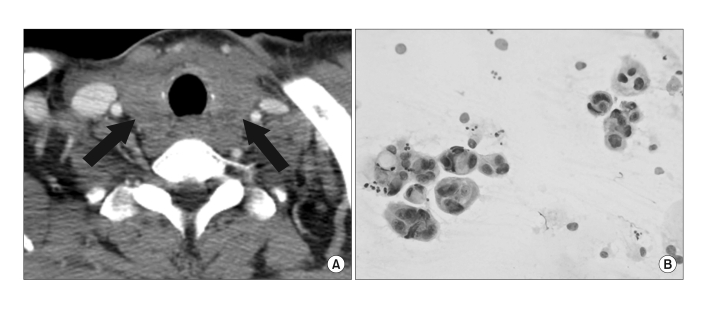Cancer Res Treat.
2009 Mar;41(1):56-58.
Severe Hypothyroidism Induced by Thyroid Metastasis of Cholangiocarcinoma
- Affiliations
-
- 1Department of Internal Medicine, Chonnam National University Medical School, Gwangju, Korea. ijchung@chonnam.ac.kr
- 2Department of Pathology, Chonnam National University Medical School, Gwangju, Korea.
- 3Department of Radiology, Chonnam National University Medical School, Gwangju, Korea.
Abstract
- We report a case of severe hypothyroidism in a cholangiocarcinoma patient with metastasis to the thyroid gland. A 58-year-old man was admitted for upper abdominal discomfort and multiple palpable neck nodules. Abdominal computed tomography (CT) demonstrated the presence of a 4.7-cm tumor in the right hepatic lobe, and core needle biopsy revealed it to be cholangiocarcinoma. Neck CT showed a diffuse, low attenuation thyroid gland, and fine-needle aspiration (FNA) demonstrated metastatic adenocarcinoma. Thyroid function tests were initially normal, but the size of the thyroid gland decreased and severe hypothyroidism developed after chemotherapy was implemented for cholangiocarcinoma. In a patient with malignant disease and a goiter, the possibility of a metastatic tumor involving the thyroid should be seriously considered. Metastatic thyroid cancer and thyroid dysfunction are probably infrequent, but diagnosis is important in the institution of appropriate therapy.
MeSH Terms
Figure
Reference
-
1. Kim TY, Kim WB, Gong G, Hong SJ, Shong YK. Metastasis to the thyroid diagnosed by fine-needle aspiration biopsy. Clin Endocrinol (Oxf). 2005; 62:236–241. PMID: 15670202.
Article2. Nakhjavani MK, Gharib H, Goellner JR, van Heerden JA. Metastasis to the thyroid gland. A report of 43 cases. Cancer. 1997; 79:574–578. PMID: 9028370.3. Wood K, Vini L, Harmer C. Metastases to the thyroid gland: the royal marsden experience. Eur J Surg Oncol. 2004; 30:583–588. PMID: 15256229.
Article4. Eriksson M, Ajmani SK, Mallette LE. Hyperthyroidism from thyroid metastasis of pancreatic adenocarcinoma. JAMA. 1977; 238:1276–1278. PMID: 578180.
Article5. Miyakawa M, Sato K, Hasegawa M, Nagai A, Sawada T, Tsushima T, et al. Severe thyrotoxicosis induced by thyroid metastasis of lung adenocarcinoma: a case report and review of the literature. Thyroid. 2001; 11:883–888. PMID: 11575859.
Article6. Hull OH. Critical analysis of two hundred twenty-one thyroid glands; study of thyroid glands obtained at necropsy in Colorado. AMA Arch Pathol. 1955; 59:291–311. PMID: 14349472.7. Abrams HL, Spiro R, Goldstein N. Metastases in carcinoma; analysis of 1,000 autopsied cases. Cancer. 1950; 3:74–85. PMID: 15405683.8. Wychulis AR, Beahrs OH, Woolner LB. Metastasis of carcinoma to the thyroid gland. Ann Surg. 1964; 160:169–177. PMID: 14209716.
- Full Text Links
- Actions
-
Cited
- CITED
-
- Close
- Share
- Similar articles
-
- Thyroid Dysfunction Induced by Metastatic Thyroid Cancer: Report of Two Cases
- Hypothyroidism
- Respiratory Failure Induced by Severe Hypothyroidism in a Korean Woman
- Hypothyroidism With Acute Renal Failure and Heart Failure
- Hyponatremia after Thyroid Hormone Withdrawal in a Patient with Papillary Thyroid Carcinoma



